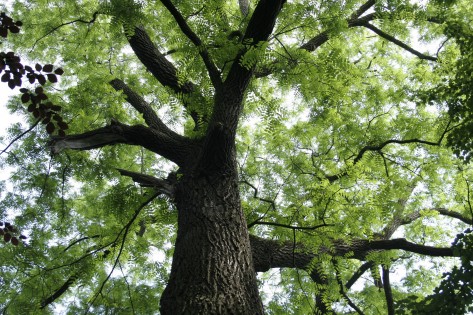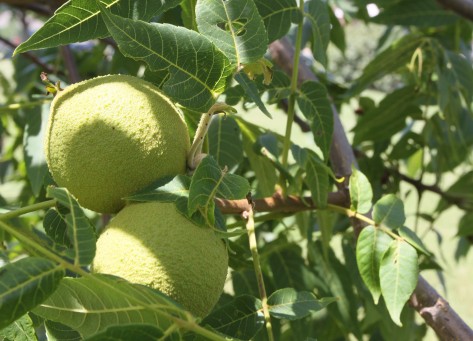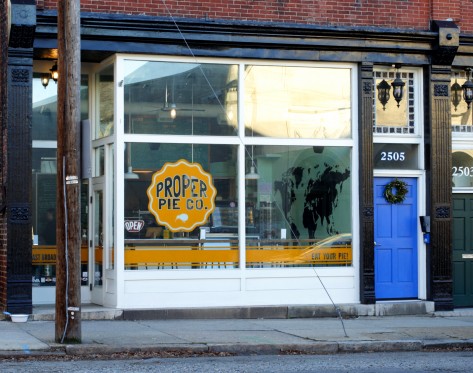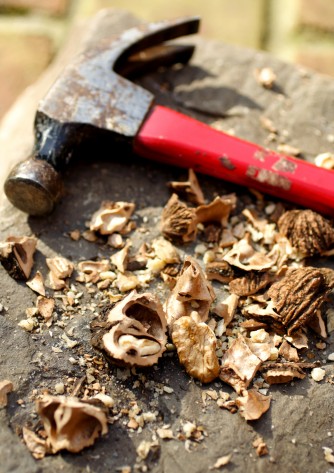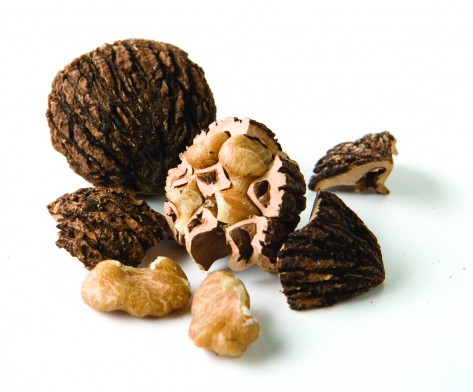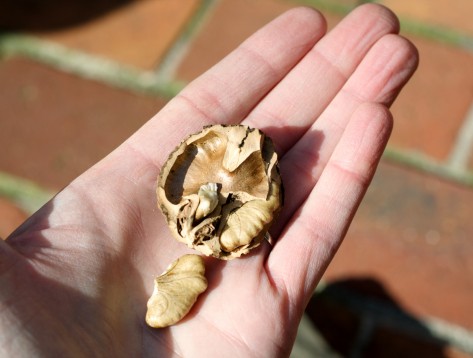Black Walnuts—A Story of Love Lost and Regained
Some new experiences are best undertaken with a guide: sky diving, rock climbing, foraging for wild mushrooms. Acquiring a taste for the Eastern Black Walnut (Juglans nigra) is another. Don’t go it alone.
The English at Jamestown were blessed to have the Powhatans as culinary guides in a new land, and it is they who likely introduced the colonists to the native black walnut, a nut with more protein than any other tree nut as well as high levels of healthy fats (omega-3 fatty acids and oleic acid), selenium, manganese, and vitamin A. To a starving settler, the extra effort required to hull and shell this unfamiliar nut would have been worth it, to get at the nutritional riches inside.
Today the nutritional value of black walnuts is lost on most of us because most of us consume them in sweets—from ice cream and cakes to fudge, brownies, and pies. If you grew up eating black walnuts, you might think nothing of snacking on them, but you are the rare bird; for many, the assertive flavor black walnut is too strong for nibbling out of hand, regardless of their health benefits.
The first lure that hooked me was black walnut ice cream. I order this flavor whenever I come across it, which is seldom, and the last time I encountered it was probably four or five years ago. Still, no matter how much time would pass between scoops, the memory of its distinctive flavor lingered.
The Black Walnut Maple Pie from Proper Pie, a sweet and savory pie shop located in easy pastry-whiffing distance from my apartment, was the second lure. This pie, sort of a hybrid of a treacle tart and pecan pie though made with black walnuts, flavored with orange zest, and sweetened with maple syrup, immediately brought back my memory of the elusive black walnut ice cream and its beguiling flavor.
What both the ice cream flavor and pie share is an adult appeal. The unique pungent flavor of black walnuts adds an unexpected dimension to desserts that can be hard to pin down for eaters without prior black walnut experience. All nuts function in desserts the same way that super dark chocolate or lemon juice or booze or wine does, as a counterpoint to sweetness. Except that the black walnut has a noticeably sour taste, a taste usually associated with fermented or aged foods. Black walnuts have umami, and lots of it.
Robert Cataldo, a Proper Pie staff member, told me, while sweeping his arm up and over his head in a wide circular motion, that when describing the Black Walnut Maple Pie to curious customers who have never tried it, he puts it this way: “Compared to pecan pie, the flavor of the black walnut pie has a much bigger flavor arc.”
Black walnut ice cream, and now this pie . . . I needed no more persuading. I would get myself a bag of black walnuts and begin experimenting with their intriguing flavor in my own kitchen. None were in stock at my local grocery stores, so I ordered an economically priced five-pound bag online.
When my large bag of black walnuts arrived I discovered that no amount of black walnut ice cream or pie can prepare you for the experience of the nut up close and personal.
First there was the aroma. Overpowering, even at a distance, it seemed to combine all of the off food smells you could imagine—soured milk, overly ammonia-ized soft cheese—into one and multiplied. The nuts smelled rancid.
It’s difficult to have an open mind to flavor when the olfactory are assaulted. But I did try. The flavor was outside of the realm of any nut experience I’d had. It was beyond nut—and was in the realm of funk, with a lingering off-flavor.
Is this how black walnuts are supposed to smell and taste? Are these the same black walnuts that were used in the desserts I had romanticized? Had I been blind to their true flavor?
Off to Proper Pie I went with a sample of the nuts. Since they use them in their baking, they would know. Neil Smith, co-owner with his wife, Nikki Price, and staff member Liza Bowers, who grew up eating black walnuts in West Virginia and North Carolina, said there was nothing wrong with my black walnuts. That’s how they are. I offered Liza some of my huge stash of nuts, but she declined, saying her parents had recently sent her a freezerful.
Dismayed, I returned home. I was stuck with five pounds of this strong-tasting nut that I could only imagine using in very small increments—a few tablespoons at most—lest they funkify whatever they touched.
The best way to use them, I decided, was as concentrated doses of umami, in the same way you would use other potent ingredients, such fish sauce, Parmesan cheese, capers, anchovies, sun-dried tomatoes, dried mushrooms. I had small successes this way, adding tablespoon amounts of the nuts to mushroom stock or walnut parsley pesto or orange zest–flavored maple syrup to top buckwheat cakes, but at that rate, it would take me ten years to work through five-pound bag.
The worst outcome of my misadventure was that I could no longer enjoy the Black Walnut Maple Pie from Proper Pie. The strong smell and taste of the black walnuts—burnt into my nose and onto my tongue—was now all I could taste when eating a slice of my once favorite pie.
Redemption
Nearly a year passed, and I found myself on an unusually warm Christmas Eve, tucked into Chop Suey Books, waiting for the incessant rain to let up. When WonTon, the resident bookstore cat, was no longer receptive to my attentions, I wandered over to the magazine rack to look for the most recent issue of Garden & Gun magazine. A couple of weeks earlier, my husband had mentioned seeing a story about black walnuts in the magazine; perhaps the story would contain some helpful bit of information that I’d overlooked.
For the December/January 2016 issue of the magazine, writer Jenny Everett had made black walnuts the topic of her column “What’s in Season.” This sentence caught my attention:
“When selecting black walnuts, make sure they have a pleasing woody aroma (overripe nuts will have a rancid odor), and store them in an airtight container in the freezer.”
A rancid odor! There it was—my glimmer of hope. Could it be that the batch I’d received was rancid? I quickly requested a sample from Hammons, the recommended black walnut source listed in Everett’s column, so that I could do a side by side comparison.
The first difference I noted between the two was the smell. The bag of nuts from Hammons did not emit a strong odor and the flavor of the Hammons’ was strong, as to be expected of a black walnut, but much less so than the first batch, and nothing unsavory lingered on the tongue. They had a clean taste.
During the year that passed between bags one and two of black walnuts, I would snatch conversations with Liza about black walnuts whenever I found her behind the counter at Proper Pie and there wasn’t a customer in line behind me, which was rare. No matter how long the line is at this small shop for it seasonal selection of two dozen plus savory and sweet pies, which sometimes goes out the door and down the sidewalk, patrons and staff alike are patient and in good humor. One time I commented to Liza about how happy she always seems. “I work in a pie shop, how could I not be?”, she replied.
During those slow moments at the shop, Liza would share some of the ways she likes to use black walnuts in cooking and baking, and I would tell her of my difficulty in making my way through the huge portion in my freezer. She is a vegan, and, in addition to making sweets with the nuts, likes to use them in savory preparations—especially fried croquettes—to add an earthy, meaty flavor, and for their nutritional value. She told me how black walnuts are a big deal in the part of West Virginia where she was born and spent summers growing up. (To celebrate the black walnut, locals hold the Spencer Black Walnut Festival each fall, and have done so since 1954.) I would often end our quick chat with the same question: Do you need any black walnuts yet? No, she still had plenty.
As soon as I got my new batch of black walnuts from Hammons, I took a sample of each batch of black walnuts to Liza. She immediately noted the difference, saying, “Oh yes, those [referring to the first batch] are over ripe, but some people prefer them that way. That’s how my parents grew up eating them.”
Inwardly, a needle screeched loudly across vinyl and came to a sudden stop and, in a flash, like an atom split into nuclei, the already niche taste for black walnuts was revealed as a world of infinite preferences, from full funk to the least possible, and everything in between.
“Ripe,” Liza explained, in this context does not refer to how long the nut ripens on the tree. Rather, after the nuts fall from the tree they are gathered and placed in buckets to “ripen.” During this time the outer husk or hull completely softens. She said it’s too hard to remove otherwise. Liza believes is probably a correlation between how long the hull is allowed to dry out—sort of a controlled rot—and the resulting flavor and aroma of the nut: more rot, more funk.
This tactic for dealing with the hull is completely different from anything I’d found online. From agricultural extension services (click here and here) and blogs (click here and here) to living-off-the-grid, homesteading, or farming journals (click here, here, and here) as well as several YouTube videos (click here, here, and here), everyone seems to remove the hull soon after the fallen nuts are gathered. Then, once hulled, the nuts are cured, or dried, for several weeks—about four weeks is the average—before cracking.
Two Birds, One Stone
Is the practice of leaving the hull on to turn black and dry out and a taste for over ripe black walnuts specific to West Virginia? Though there is plenty of commentary on the Web about the assertive flavor of black walnuts, and it being an acquired taste for many, there is no discussion of a preference for a stronger “ripe” flavor as opposed to a more mild flavor, mild being a relative term here since black walnuts are one of the strongest tasting nuts on the face of the earth.
I called Liza’s mother, Carolyn Bowers, to find out more.
Carolyn has never bought a black walnut, though she’s eaten them her whole life. She has hulled and cracked them the same way since she was a girl, following the same method her father and grandfather used. And, as far as she knows, everyone else in and around Spencer, West Virginia, where she grew up, did the exact same thing.
That thing is to gather the nuts after they fall in October and lay them out to dry. As the husk deteriorates, it will turn black and shrivel up. When all or part of the husk has fallen off, and any remaining husk is dried enough to be easily scraped off, the nuts are considered “ripe” and ready to crack and eat. The period of time the hulls are allowed to turn black and dry is generally six to eight weeks. When ripening, Carolyn said they would sometimes lay the nuts out on the ground near the house or simply placed them in buckets. Carolyn recalled that her grandfather would also put them in a corncrib in an outbuilding to ripen.
Carolyn feels that this is the best method to use. If you try to hull the walnuts when the outer husk is yellow-green to brown, and still has lots of moisture it in, you will have to contend with the juices of the inner husk that will leave your hands stained for weeks. (The staining juices of the inner husk can be used to create dye that ranges in color from yellowish brown to brownish black, depending on when it is extracted.)
This strikes me as very practical. The difficult and messy job of removing the hull is simplified—why struggle with removing it and have to contend with the staining juices when you can let it rot off—and what is usually a two-step process of hulling and curing is combined into one.
A Rock and a Hammer
“Back in the day,” Carolyn recounted, “my grandfather would take me and my sister out and we’d gather nuts in old feed sacks. We’d let them dry, then in the wintertime we’d sit in front of the fire when it was cold and snowy and crack nuts and eat them. And not just black walnuts. We’d also have hazelnuts and hickory nuts, too, because they grew wild in West Virginia as well.”
Aside from snacking on black walnuts, Carolyn’s mother used them in desserts, especially cakes and brownies. But Carolyn doesn’t remember her mother cracking too many black walnuts. “She was pretty smart about that: ‘You crack the nuts,’ she’d say, ‘and I’ll make the brownies.’”
Cracking the nuts was done with a hammer on a rock. A typical nut cracker, Carolyn commented, wouldn’t be up to the task.
I observed that the combination of hammers, child-sized hands, and the sharp corners on the outside and inside of the black walnuts sounds like a recipe for hurt fingers.
There were lots of sore fingers, Carolyn admitted, but her memory of those hammer-wielding sessions is of a fun time, a time spent with family that resulted in something really good to eat.
Today Carolyn still cracks black walnuts the same way, with a hammer and rock, and not always in the wintertime. On the first warm days of spring she and her husband have a tradition of gathering up the remaining black walnuts that have over-wintered on the ground, if the squirrels haven’t carted them all away. Sitting on a nearby bench, they scrape off any remaining husk and crack them with a dedicated rock and hammer.
Carolyn’s generation’s old solution to the problem of the mess and difficulty in hulling and shelling black walnuts is just one, and probably the simplest, of several possible ways to accomplish the same goal.
In a response to my questions about the hulling process, Dennis M. of the University of Minnesota Extension Service described some of the methods you might try for hulling black walnuts:
“[Hulling] options include driving over them; crushing between stones; tumbling in a concrete mixer; or drilling a hole the size of a shelled nut on a piece of hard wood, placing the wood over a bucket, placing a walnut & husk on the hole then hit it with a rubber mallet driving the nut into the bucket, and then wiping the husk off and repeat until finished.”
But this is not all. Some black walnut fans, not satisfied with the existing methods of hulling the nuts, like running over them with a car—a method deemed unsafe by some because a flying black walnut really could put an eye out—have invented mechanical hulling machines. Others have made the job of shelling the nuts the focus of their inventions, either to speed up the process or to finesse it to end up with the largest pieces of walnut meat possible. (Because some force must be applied to crack a black walnut shell, most black walnut meats get broken, so a whole, intact black walnut meat is a rare and prized thing.)
I can think of no better expression of American culture than these homespun inventions, where hand-staining, rock-hard native nut meets the spirit of American inventiveness. (See the links to my favorites of these inventions, demonstrated in YouTube videos, below.)
Without doubt, however, the large professional hulling machines used at designated hulling stations do the job the most efficiently and effortlessly. In the fall, station operators are busy hulling wild nuts hand gathered by people who appreciate the chance to earn some extra cash or carry on a seasonal tradition, or a little of both. After the nuts are hulled, the hull operators weight the nuts and pay foragers a per pound rate. Carolyn said gathering wild black walnuts and taking them to the hulling station for payment was a popular thing for young people to do when she was growing up. Carolyn’s sister, as teenager, paid for her first horse this way, with buckets of black walnuts.
A Missouri Dandy
After the black walnuts are hulled at hulling stations, they are sent off to be processed. And probably 99.9 percent of the time the place they are sent to is Stockton, Mo, the home of the Hammons Products Company, established in 1946 by Ralph Hammons. Today Hammons is the world’s largest processor of black walnuts; almost all of the shelled black walnuts you encounter likely come from Hammons, whether they are co-packaged and sold under a different company label or are used by the food industry to make sweets, especially black walnut ice cream.
By October 1st, Hammons treks its hulling machines to 215 hulling stations located in twelve different states, each run by an independent contractor. Being a wild crop and owing to the fact that the black walnut is an alternate bearing species—meaning, the trees produce nuts in two-year cycles—the harvest can vary greatly from year to year. Last year, Hammons purchased 10 million pounds of nuts. But that was a small harvest compared to the 2014 and 2013 harvests, which totaled 22 million and 30 million pounds respectively. Even with the company’s multi-state network, 60 to 65 percent of the black walnuts Hammons buys comes from its home state. (There’s a reason why the black walnut is the state tree nut of Missouri.)
After the nuts arrive at Hammons, they are naturally dried, or cured, in barns. A sample cracking is done to determine if they’re sufficiently dried. When they’re ready to be cracked, they’re run through the “cracker”—a specially designed machine consisting of two steel rollers calibrated to use the least amount of force possible to crack the shells—then they are sorted, first by a machine and then by human hands, and bagged.
In addition to the wild nuts, Hammons processes cultivated, or “improved,” varieties of the black walnut and packages them under its Missouri Dandy label, which is illustrated with a top-hat-wearing dandy strutting, cane in hand, past a proud black walnut tree, framed by the St. Louis Arch. This label is not terroir branding used to signify nuts that are sourced only from Missouri, as I assumed at first.
Susan Zartman, Director of Marketing at Hammons, explained to me in a phone conversation that the Missouri Dandy label is part of Hammons’ history: It is the label they used for the very first nuts packaged they sold in the retail market, which at that time all did come from Missouri. Today the nuts sold under this label, which the company describes as “Premium Fancy Large,” come from multiple states but all come from cultivated varieties of the tree grown in orchards.
The distinguishing differences between the wild and cultivated varieties are size and flavor: the nut meat from cultivated varieties is about five times as large as the wild nut meats and the flavor is milder, giving them wider appeal.
Aside from the shelled wild and cultivated varieties, Hammons also sells the wild nuts in their shells, cured and ready to crack.
In lieu of sending Susan a sample of my first batch of super strong smelling and tasting black walnuts for comparison, I did my best to describe them to her. I wanted to know what it is that could make the two batches taste and smell so different?
Susan is not familiar with the practice of leaving the hull on the nut until it rots and practically falls off. Aside from slight differences in flavor between the nuts wild and cultivated trees, she believes the single biggest impact on the flavor of black walnuts is the high amount of oil in the nut and how the nuts are stored, particularly once shelled. For this reason, Susan said she made a point of sending me a bag of shelled wild nuts that has just been processed and bagged so that I would experience them at their freshest.
Indeed, black walnuts are very oily; when you toast them, you can see the oil glistening on the surface of the nut as the heat draws it out. It’s not hard to imagine that if the shelled nuts are stored at room temperature, the oils in the nuts would go rancid quickly and develop a strong odor and flavor, a trade-off for a food that has among the highest vegetarian amounts of Omega-3s.
To keep the nuts as fresh as possible, Hammons keeps them in cold storage. Once the nuts leave Hammons, however, there are unknown variables: Co-packers may not keep the nuts in cold storage and the nuts may sit for some time on a grocery store shelf before being sold. This is likely the reason why the first batch of nuts I received from another company, one that Susan said they sell nuts to for co-packing, had a stronger aroma and flavor than the ones I received directly from Hammons.
So, when purchasing shelled black walnuts, to insure you receive the freshest nuts possible, your best bet is to order a batch directly from Hammons in the late fall or winter and, as soon as you get them, stick them in the fridge for short-term storage or the freezer for longer-term storage. On the other hand, if you gather, hull, dry, and crack black walnuts yourself, you can have them just as fresh as you like.
Susan recommends toasting black walnuts to mellow their flavor. I tried this, and they are delicious this way: the upfront sour taste so noticeable in the raw nuts retreats and in its place a rich, earthy flavor with sweet notes dominates.
In Love Again
Back at the pie shop, I’ve fallen in love again with the Black Walnut Maple Pie. With the toned-back flavor of the black walnuts from Hammons lingering on my tongue, I can once again appreciate the mastery of that pie. To celebrate, last time I was at Proper Pie, I sat at the counter and savored a slice topped with whipped cream and watched the staff chatting with and dispensing pies to a stream of customers, occasionally stopping in their work to lower the large chalkboard on pulleys and erase a pie they’ve just sold out for the day. Being a niche taste, there were still several slices of Black Walnut Maple Pie available. I couldn’t have been happier.
Thanks to my black walnut guides
Liza Bowers
Carolyn Bowers
Susan Zartman
Robert Cataldo
Jenny Everett
Neil Smith and Nikki Price
All of the people who make black walnut ice cream
Sourcing Hammons Nuts
*The shelled Missouri Dandy nuts and the whole wild nuts in the shell are available only from the Hammons website.
*The shelled wild nuts are available year-round from Hammons website and seasonally in grocery stores, often in the fall and winter for use in holiday baking and when the nuts are freshest.
Foraging for black walnuts
Visit Falling Fruit.
Proper Pie
2505 East Broad Street, Richmond, VA
Get your pie Wednesday–Saturday, from noon to 7 p.m., and on Sundays from noon to 6 p.m.
To watch Americans demo their inventions to hull and shell black walnuts:

